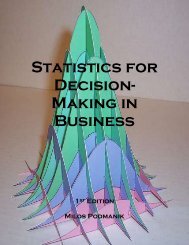Tutor Training Manual.indd - Chandler-Gilbert Community College
Tutor Training Manual.indd - Chandler-Gilbert Community College
Tutor Training Manual.indd - Chandler-Gilbert Community College
You also want an ePaper? Increase the reach of your titles
YUMPU automatically turns print PDFs into web optimized ePapers that Google loves.
Advantages of <strong>Tutor</strong> Prompt Student Respond<br />
13<br />
• Focuses attention on the topic keeps the session on track.<br />
• Focuses attention on the student, not the tutor.<br />
• The student is an active learner.<br />
• Helps the student gain self confidence as a learner.<br />
• The tutor can assess the student’s knowledge and understanding.<br />
• Demonstrates an effective learning strategy that the student can apply independently.<br />
Disadvantages of <strong>Tutor</strong> Prompt Student Respond<br />
• Can turn into a frustrating guessing game (Guess what’s in my head).<br />
• Can become an interrogation (Since you don’t know A, then do you know B).<br />
• Can be frustrating for the tutor if the student doesn’t respond.<br />
• Student may come to feel inadequate.<br />
• Questions may seem like threats.<br />
• Questions may be seen as prompts for thought and consideration rather than a<br />
response.<br />
• Some students respond better to being shown what to know and then asked to repeat it.<br />
• Sometimes it is more efficient to exchange information rather than prompt.<br />
Common Prompts and Responses<br />
Common Prompts<br />
A direct question: “What is a light year”<br />
A fill-in question: “A light year is…”<br />
Challenge with problems: “A star is<br />
1000 light years from earth. How far away<br />
is that in miles”<br />
Be a devil’s advocate: “I don’t believe in<br />
black holes. How do you know they actually<br />
exist”<br />
Seek alternatives: “I’ve heard it said the<br />
other way, how do you know this is right”<br />
Missing piece: “Light travels at 186,000<br />
miles per second. Now, can you calculate a<br />
light year”<br />
Common Responses<br />
Answer a question: “A light year is the<br />
distance traveled by light in a year.”<br />
Explain an answer:<br />
-How we arrived at our answer.<br />
-The thought process underlying a process<br />
or concept.<br />
Summarize progress so far:<br />
-The steps to arrive at an answer.<br />
-The relationship of one concept to another.<br />
Evaluate:<br />
-How the student is progressing.<br />
-How tutoring is progressing.<br />
-How tutoring is structured.<br />
Brainstorm: “What else can we think of<br />
to explain that”<br />
Tips for using the Prompt Response Method<br />
1. Wait...be patient. Give the student time to think about and respond to a prompt. Don’t<br />
rush to fill in the answer.<br />
2. Ask one question at a time. Don’t ask questions in rapid fire succession or it will seem<br />
like an inquisition.<br />
3. Use learning resources. Use the text, lecture notes, and other learning resources to<br />
demonstrate where to find answer to questions. Don’t give message that the tutor is the<br />
only source of information.

















